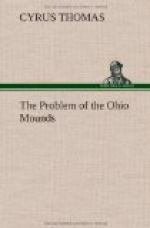These graves, as is well known, are formed of rough and unhewn slabs or flat pieces of stone, thus: First, in a pit some 2 or 3 feet deep and of the desired dimensions, dug for the purpose, a layer of stone is placed to form the floor; next, similar pieces are set on edge to form the sides and ends, over which other slabs are laid flat, forming the covering, the whole when finished making a rude, box-shaped coffin or sepulcher. Sometimes one or more of the six faces are wanting; occasionally the bottom consists of a layer of water-worn bowlders; sometimes the top is not a single layer of slabs, but other pieces are laid over the joints, and sometimes they are placed shingle-fashion. These graves vary in length from 14 inches to 8 feet, and in width from 9 inches to 3 feet.
It is not an unusual thing to find a mound containing a number of those cists arranged in two, three, or more tiers. As a general rule, those not in mounds are near the surface of the ground, and in some instances even projecting above it. It is probable that no one who has examined them has failed to note their strong resemblance to the European mode of burial. Even Dr. Joseph Jones, who attributes them to some “ancient race,” was forcibly reminded of this resemblance, as he remarks:
In looking at the rude stone coffins of Tennessee, I have again and again been impressed with the idea that in some former age this ancient race must have come in contact with Europeans and derived this mode of burial from them. [Footnote: Aboriginal Remains of Tennessee, pp. 34,35]
The presence of stone graves of the type under consideration in the vicinity of the site of some of the “over hill towns” of the Cherokees on the Little Tennessee River, presented a difficulty in the way of the theory here advanced, as it is well known that the Cherokees and Shawnees were inveterate enemies from time immemorial. But by referring to Schoolcraft’s History of the Indians the following statement solves the riddle and confirms the theory:
A discontented portion of the Shawnee tribe from Virginia broke off from the nation, which removed to the Scioto country, in Ohio, about the year 1730, and formed a town known by the name of Lulbegrud, in what in now Clark County [Kentucky], about 30 miles east of this place [Lexington]. This tribe left this country about 1730 and went to East Tennessee, to the Cherokee Nation. [Footnote: Vol. 1, p. 301.]
Some years ago Mr. George E. Sellers discovered near the salt spring in Gallatin County, Ill., on the Saline River, fragments of clay vessels of unusually large size, which excited much interest in the minds of antiquarians, not only because of the size of the vessels indicated by the fragments, but because they appeared to have been used by some prehistoric people in the manufacture of salt and because they bore impressions made by some textile fabric. In the same immediate locality were also discovered a number of box-shaped stone graves. That the latter were the work of the people who made the pottery Mr. Sellers demonstrated by finding that many of the graves were lined at the bottom with fragments of these large clay “salt pans.” [Footnote: Popular Science Monthly, vol. II, 1877, pp. 573-584.]




